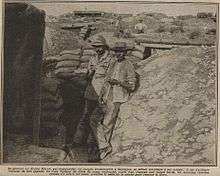Bryan Mahon
| Sir Bryan Mahon | |
|---|---|
 Bryan Mahon | |
| Born |
2 April 1862 Galway, Ireland |
| Died |
29 September 1930 (aged 68) Dublin, Ireland |
| Allegiance |
|
| Service/branch |
|
| Rank | General |
| Commands held |
10th (Irish) Division Western Frontier Force Commander-in-Chief, Ireland |
| Battles/wars |
Second Boer War World War I |
| Awards |
Knight Commander of the Order of the Bath KCMG Distinguished Service Order |
General Sir Bryan Thomas Mahon KCB KCVO PC DSO (2 April 1862 – 29 September 1930) was an Irish born general of the British Army and Senator of the Irish Free State.
Biography
Mahon was born at Belleville, County Galway on 2 April 1862. He became a lieutenant in the 8th (King's Royal Irish) Hussars in 1883. He served in Sudan in the Dongola Expedition in 1896 as Staff officer to Sir Herbert Kitchener, and was present at the Battle of Ferkeh and the operations at Hafir. In 1899 he took part in the final defeat of the Khailfa as Assistant Adjutant general in charge of Intelligence, and was mentioned in despatches (dated 25 November 1899) by Colonel Wingate with the following words:
I cannot speak in sufficiently strong terms of the excellence of the services performed by this officer. I invariably placed him in general command of all the mounted troops; his personal disregard for danger, intrepid scouting, and careful handling of men, all fit him for high command; his bold and successful seizure of the position in front of Fedil's camp, and his conduct of the fight before I came up, show him to possessed of exceptional qualities as a commander.[1]
During the Second Boer War Colonel Mahon led a flying column 2,000 strong, and consisting mainly of South African volunteers from Kimberley, which came to the Relief of Mafeking. The town, which had been under siege for seven months by Boer forces, was facing starvation. Mahon was appointed a Companion of the Order of the Bath (CB) for his services during the operations,[2] and was invested with the order by King Edward VII on 2 June 1902.[3]
He was briefly Governor of Khartoum in 1903.

During the First World War he commanded the 2nd (Sialkot) Cavalry Brigade and the 10th (Irish) Division during the Gallipoli Campaign. The 10th Division landed at Suvla Bay on the night of 6–7 August 1915. In September he moved with the Division to be head of the British Salonika Army to support Serbia at the onset of the Macedonian campaign. In 1916 General Mahon took up command of the Western Frontier Force in the Egyptian Expeditionary Force.[4]
He was then appointed as the Commander-in-Chief, Ireland in 1916 in the lead up to the Anglo-Irish war. He retired from the British Army at the end of August 1921.[5]
After his retirement he was elected as a privy council member of the short-lived Senate of Southern Ireland.[6] He was appointed to Seanad Éireann by the President of the Executive Council, William T. Cosgrave, in 1922 and 1925. He was elected to the Seanad in 1928, and served until his death in 1930.[7]
Mahon was appointed a Fellow of the Royal Geographical Society (FRGS) in May 1902.[8]
References
- ↑ The London Gazette: no. 27159. pp. 598–600. 30 January 1900.
- ↑ The London Gazette: no. 27359. p. 6303. 27 September 1901.
- ↑ "The King´s Levee and Investiture". The Times (36784). London. 3 June 1902. p. 10.
- ↑ Sir Archibald Murray's Despatch of 1916 Archived November 21, 2007, at the Wayback Machine.
- ↑ The London Gazette: (Supplement) no. 32441. p. 6912. 30 August 1921.
- ↑ The Senate of Southern Ireland, 1921
- ↑ "Rt. Hon. Sir Bryan Mahon". Oireachtas Members Database. Retrieved 12 October 2015.
- ↑ "Court Circular". The Times (36767). London. 14 May 1902. p. 12.
External links
| Wikimedia Commons has media related to Bryan Mahon. |
- The Relief of Mafeking by Filson Young at Project Gutenberg, by Filson Young at The Project Gutenberg
| Military offices | ||
|---|---|---|
| Preceded by New post |
General Officer Commanding the 10th (Irish) Division 1914–1915 |
Succeeded by John Longley |
| Preceded by Charles C. Monro |
Commander of the British Salonika Army 1915–1916 |
Succeeded by George Milne |
| Preceded by John Maxwell |
Commander-in-Chief, Ireland 1916–1918 |
Succeeded by Frederick Shaw |